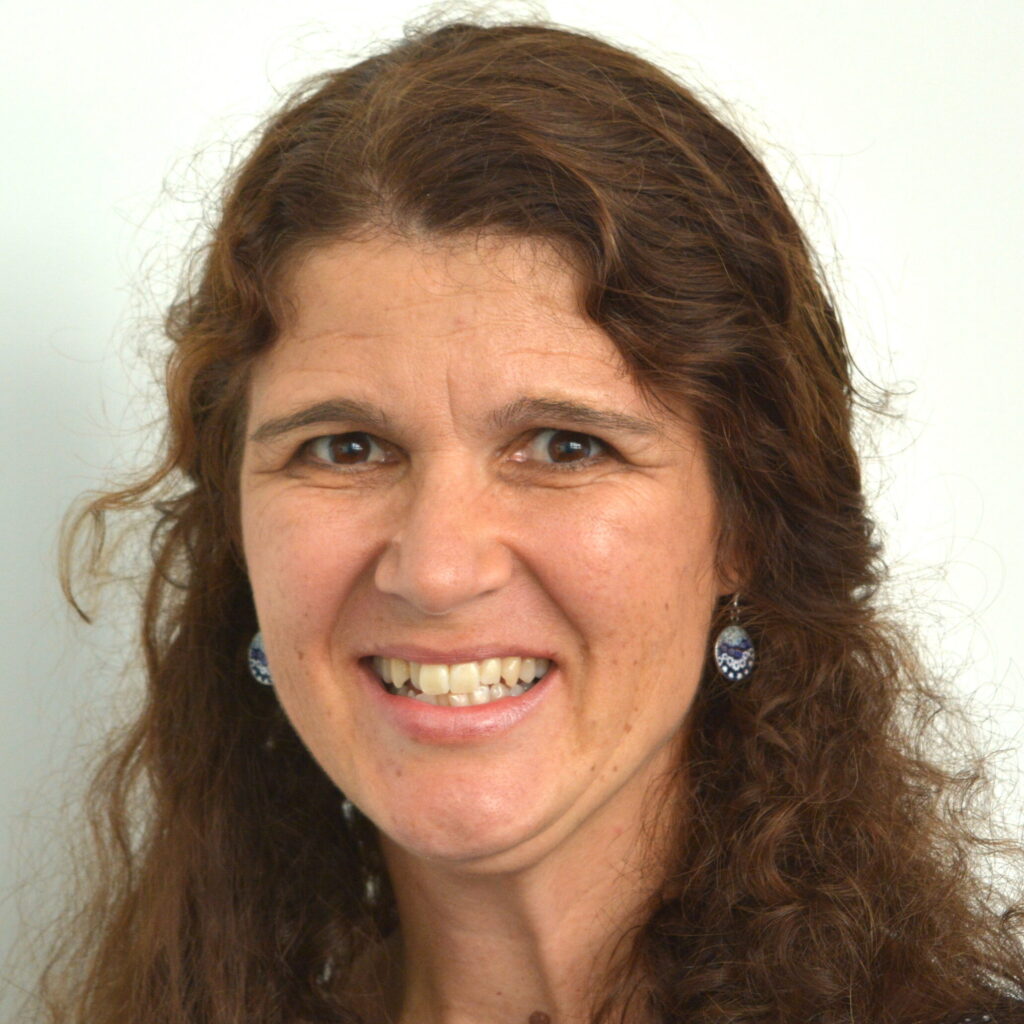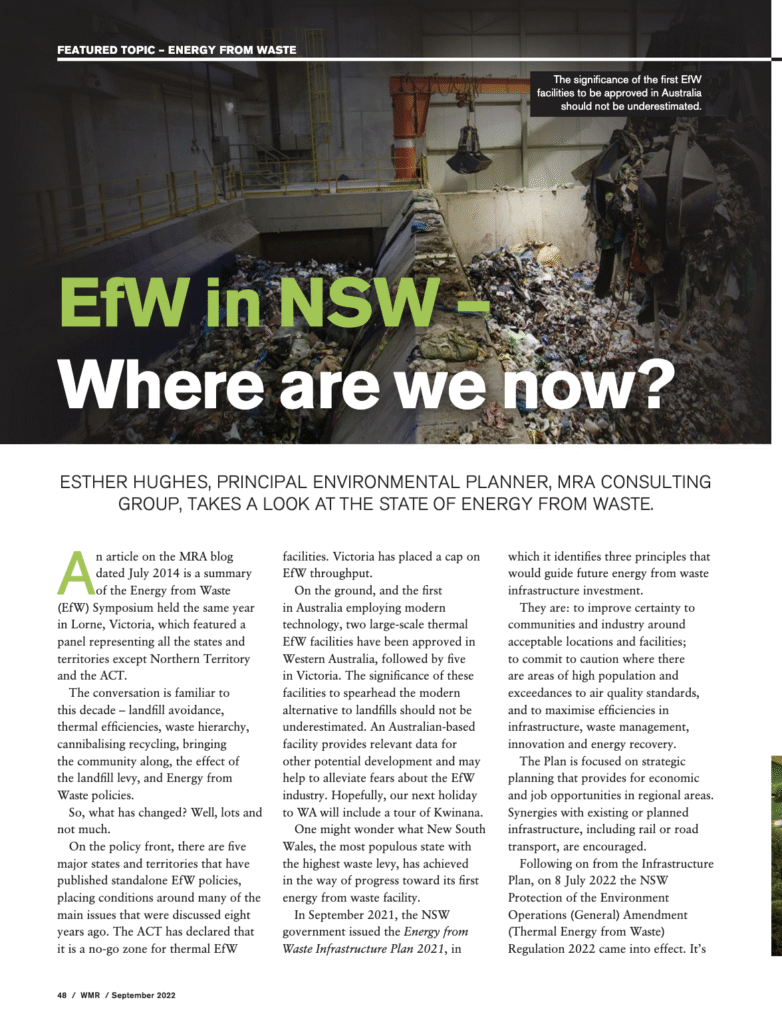The state of EfW in 2022
By Esther Hughes, Principal Environmental Planner, MRA Consulting Group

An early article on the MRA blog is dated July 2014. It is a summary of the Energy from Waste (EfW) Symposium held the same year in Lorne, Victoria and features a high-powered panel representing all the states and territories except NT and the ACT.
The conversation sounds familiar to this decade – landfill avoidance, thermal efficiencies, waste hierarchy, cannibalising recycling, bringing the community along, the effect of the landfill levy, and Energy from Waste policies.
So what has changed? Well, lots and not much.
On the policy front, there are five major states and territories that have published standalone EfW policies, placing conditions around many of the main issues that were discussed eight years ago. The ACT has declared that it is a no-go zone for thermal EfW facilities. Victoria has placed a cap on EfW throughput.
On the ground, and the first in Australia employing modern technology, two large scale thermal EfW facilities have been approved in Western Australia, followed by five in Victoria. The significance of these facilities to spearhead the modern alternative to landfills should not be underestimated. An Australian based facility provides relevant data for other potential development and may help to alleviate fears about the EfW industry. Hopefully, our next holidays to WA include a tour of Kwinana.
One might wonder what NSW, the most populous state with the highest waste levy, has in the way of approvals for energy from waste.
In September 2021, the NSW government issued the Energy from Waste Infrastructure Plan 2021, in which it identifies three principles that would guide future energy from waste infrastructure investment. They are:
- improve certainty to communities and industry around acceptable locations and facilities
- adhere to the precautionary principle where there is a greater risk of harm to human health due to proximity to high population areas (now and in the future), and in areas where there are regular exceedances to air quality standards from existing sources
- maximise efficiencies in infrastructure, waste management, innovation and energy recovery.
The Plan is highly focused on strategic planning that provides for economic and job opportunities in regional areas. Synergies with existing or planned infrastructure, including rail or road transport are encouraged.
Following on from the Infrastructure Plan, on 8 July 2022 the NSW the Protection of the Environment Operations (General) Amendment (Thermal Energy from Waste) Regulation 2022 came into effect. It’s a bit of a mouthful, but the intent of the amendment is to enforce a blanket prohibition on the thermal treatment of waste in NSW –(energy from waste) except under certain circumstances.
The three exceptions include:
- the activity or work is carried out at certain precincts or premises, or
- the activity is an established and operating activity at the premises immediately before the prohibition comes into force, or
- the activity is carried out to replace a less environmentally sound fuel in certain circumstances.
The precincts that are not prohibited from energy from waste include:
- The Parkes Activation Precinct,
- The Richmond Valley Regional Jobs Precinct,
- The Southern Goulburn Mulwaree Precinct,
- The West Lithgow Precinct, or
- Other precinct/s which are yet to be gazetted, potentially at a former mine site or former electricity generation site.
The EfW facility is permissible if it is an established and operating facility prior to the changes to the regulation. Hence the sites in NSW that currently thermally treat waste – in Berrima and Tumut – are not impacted by the regulation.
To be eligible to establish an EfW facility that replaces a different fuel source there are four criteria:
- The replaced fuel has to be less environmentally sound.
- The facility had to be running, or was approved to run, before the amendment occurred.
- At least 90% of the replaced fuel was used for industrial or manufacturing processes at the premises in the year before the amendment occurred.
- At least 90% of the energy recovered from waste derived fuels will be used for industrial or manufacturing processes in a given year.
By way of definition, the legislation captures the recovery of electrical energy, mechanical energy, heat and fuel production. It is applicable to any licensable activity, which is a 200 tonnes per annum waste throughput limit for energy recovery.
A Special Activation Precinct (SAP) is a dedicated area in a regional location identified by the NSW government to become a thriving business hub. SAPs utilise fast-track planning, investment in infrastructure, government led studies and development / business concierge. Parkes is the first of six Special Activation Precincts (SAPs) to be developed, and has particular opportunities aligned with the east-west rail line and the Inland Rail project. The Regional Growth and Development Corporation is responsible for the delivery of the Parkes SAP, facilitating fast-track approvals for many activities, including thermal electricity generating works and waste management facilities.
The Regional Jobs Precincts is an extension of the SAP program which also aims to assist fast-track approvals, growth and investment in regional NSW. The Regional Jobs Precinct program is currently less developed than the Activation Precincts, however, specialist studies are being commissioned to investigate the Richmond Valley Precinct, before planning changes are delivered.
The effect of the new legislation is to restrict new EfW proposals to the four precinct areas or to established manufacturing or industrial sites that are able to replace less environmentally sound fuel. As a result, five planning applications in NSW for EfW facilities were terminated as they do not sit within the planned precincts.
A very high level of uncertainty arises from the NSW Energy from Waste Infrastructure Plan and associated legislation. While Parkes is the first key precinct to move ahead, with streamlined development pathways for waste infrastructure to support the strategic plan and provide industrial ecology synergies, other opportunities face significant regulatory barriers to their development. Regional areas are to benefit from job opportunities and increased in investment, however the regions are selective and bear no relationship to the availability of waste feedstock. On a positive note, within the parameters of the Energy from Waste Policy, the Energy from Waste Infrastructure Plan and the Amended PoEO (General) Regulation, NSW is set to move forward to the considered approval of their first EfW facility for thermal treatment of waste.
This article has been published by the following media outlets:




